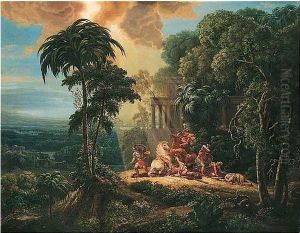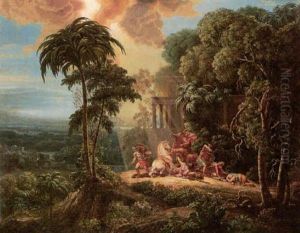George Foggo Paintings
George Foggo was a British artist born in 1793, whose work spanned the late Georgian and early Victorian eras. Though not as widely recognized as some of his contemporaries, Foggo made significant contributions to the art world through his paintings and drawings. His artistic journey reflects the rich cultural and historical shifts of his time, offering insights into the evolving tastes and social dynamics of 19th-century Britain.
Foggo's early life is somewhat obscure, with limited documentation on his formative years. However, it is known that he developed an interest in art at a young age and pursued this passion with vigor as he matured. Living through a period marked by the Industrial Revolution, the Napoleonic Wars, and significant social reforms, Foggo was exposed to a wide range of influences that shaped his artistic style.
Primarily known for his portraits and landscapes, Foggo exhibited a keen eye for detail and a profound ability to capture the essence of his subjects. His portraits, in particular, are noted for their depth of emotion and the skillful use of light and shadow, which brought his sitters to life. These works provide a window into the personalities and fashion of the era, as well as the societal importance placed on portraiture as a means of capturing and preserving identity.
Beyond portraiture, Foggo's landscapes offer a glimpse into the changing British countryside and urban settings of his time. His works often depict serene pastoral scenes or bustling city life, each rendered with a delicate touch that highlights the beauty and complexity of the natural and man-made world.
Throughout his career, George Foggo remained an active participant in the British art scene. He exhibited his works at prestigious institutions such as the Royal Academy and the British Institution, earning the respect of his peers and the admiration of art enthusiasts. Despite this, he never achieved the level of fame enjoyed by some of his contemporaries, and his work was somewhat overshadowed by the larger figures of the time.
Foggo's legacy, though modest in comparison to other artists of the era, is preserved in the collections of several British museums and in the private collections of those who appreciate the quiet beauty and historical significance of his work. He passed away in 1869, leaving behind a body of work that continues to be studied and appreciated for its contribution to the rich tapestry of 19th-century British art.

